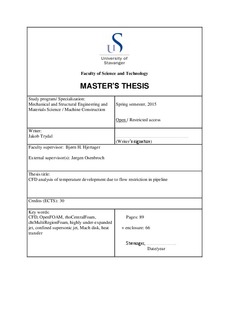| dc.description.abstract | If the pressure difference in a pipe, up- and downstream of a restriction orifice, is above a critical value, the flow becomes choked and an under-expanded jet occurs. For very large pressure differences, the gas experiences a significant temperature drop, downstream of the orifice. The cold gas causes the temperature in the pipe material to decrease and its material properties to change. In the oil and gas industry, this problem typically occurs during pressurization or depressurization of gas pipelines.
The temperature distribution in a 2” pipeline, due to a flow restriction, has been investigated, using the open-source CFD code OpenFOAM. The fluid and the pipe were simulated separately using a quasi-transient approach. The natural gas was modelled as pure methane.
The results show a minimum pipe temperature of 191,8 K (-81,2°C) compared to
177,1 K (-95,9°C) in Olga simulations performed by Aker Solutions. The upstream pipe is almost unaffected by the low temperatures, while approximately 0,5 m of the downstream pipe experiences temperatures below the minimum design temperature (-46°C). After approximately 40 seconds, the temperature in the entire pipe is above the limit. In Aker’s report, this time is estimated to 228 seconds.
A grid independence test was conducted and the temperature at the fluid surface was found to vary ±1%, when the number of cells was increased by 40%.
In the under-expanded jets, the locations and diameters of the normal shocks, known as Mach disks, are in agreement with experimental data, except for the cases with nozzle pressure ratios (NPR) above 80. The expressions that describe the Mach disk location and diameter are developed for free jets. In the cases with NPR above 80, the wall heavily influences the structure of the jets and thus the jets are no longer free.
Based on the validation against experimental data, as well as validation of the solver’s accuracy, it is assumed that the obtained results give a satisfactory estimate of the actual temperature distribution in the pipe. | nb_NO |

